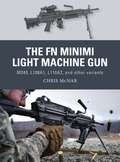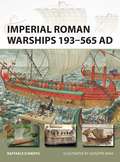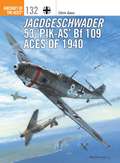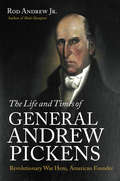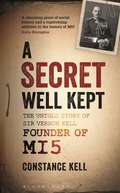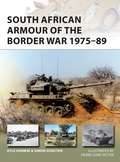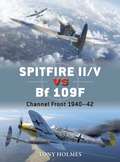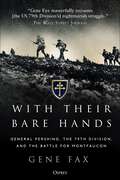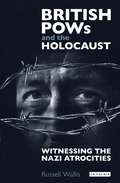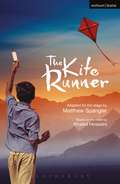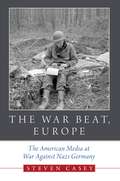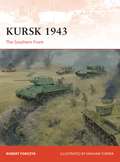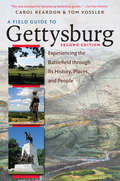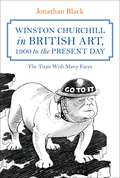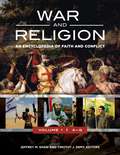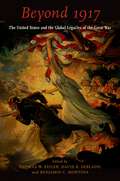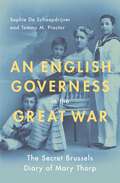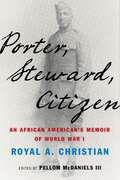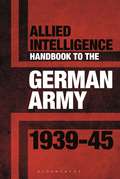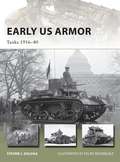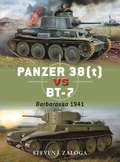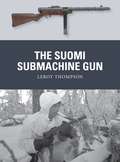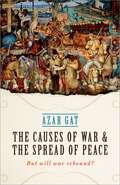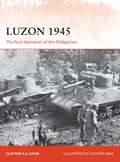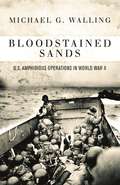- Table View
- List View
The FN Minimi Light Machine Gun: M249, L108A1, L110A2, and other variants (Weapon)
by Johnny Shumate Chris McNab Alan GillilandIn 1974, renowned Belgian arms company Fabrique Nationale brought out a ground-breaking new light machine gun, the Minimi. Its success has been meteoric, arming more than 45 countries around the world.The Minimi offers the ultimate in portable firepower. Firing the high-velocity 5.56×45mm round, the Minimi is a gas-operated, lightweight, belt- or magazine-fed weapon, able to burn through cartridges at a cyclical rate of up to 1,150 rounds per minute, making it the weapon of choice for fire support at squad level.This study uses gripping first-hand accounts and striking combat photographs, following the Minimi to war zones such as Iraq and Afghanistan. It tracks its design and development, as well as investigating what has made it so compelling a choice for armed forces around the world for more than 40 years.
Imperial Roman Warships 193–565 AD (New Vanguard)
by Giuseppe Rava Raffaele D’AmatoThe period of relative peace enjoyed by the Roman Empire in its first two centuries ended with the Marcomannic Wars. The following centuries saw near-constant warfare, which brought new challenges for the Roman Navy. It was now not just patrolling the Mediterranean but also fighting against invaders with real naval skill such as Genseric and his Vandals. With research from newly discovered shipwrecks and archaeological finds as well as the rich contemporary source material, this study examines the equipment and tactics used by the navy and the battles they fought in this tumultuous period, which includes the fall of Rome and the resurgence of the Eastern Empire under Justinian the Great.Using spectacular illustrations, carefully researched ship profiles, and maps, this third volume in Osprey's Roman Warships miniseries charts the ultimate evolution of the Roman fleet in one of the most fascinating periods of its history.
Jagdgeschwader 53 ‘Pik-As’ Bf 109 Aces of 1940 (Aircraft of the Aces #132)
by Chris Davey Chris GossBoasting pilots who had been blooded in the Spanish Civil War, Jagdgeschwader 53 (JG 53) 'Pik As' or 'Ace of Spades' achieved great success in the skies over France and Britain in 1940. It was infamous amongst its opponents for the quality and calibre of its aces – men such as Werner Mölders, Hans-Karl Mayer and Rolf Pingel. These aces won numerous Knight's Crosses for their exploits in 1940, credited with 258 victories, with 51 pilots being killed or captured. This study follows these pilots of JG 53 into battle, telling the stories of their victories, losses, and ultimate fate.Containing 36 profile illustrations depicting the drastic change in appearance of their aircraft over time, and complemented by thorough research, this book is a welcome addition to Osprey's popular Aircraft of the Aces series.
The Life and Times of General Andrew Pickens: Revolutionary War Hero, American Founder
by Rod AndrewAndrew Pickens (1739–1817), the hard-fighting South Carolina militia commander of the American Revolution, was the hero of many victories against British and Loyalist forces. In this book, Rod Andrew Jr. offers an authoritative and comprehensive biography of Pickens the man, the general, the planter, and the diplomat. Andrew vividly depicts Pickens as he founds churches, acquires slaves, joins the Patriot cause, and struggles over Indian territorial boundaries on the southern frontier. Combining insights from military and social history, Andrew argues that while Pickens's actions consistently reaffirmed the authority of white men, he was also determined to help found the new republic based on broader principles of morality and justice.After the war, Pickens sought a peaceful and just relationship between his country and the southern Native American tribes and wrestled internally with the issue of slavery. Andrew suggests that Pickens's rise to prominence, his stern character, and his sense of duty highlight the egalitarian ideals of his generation as well as its moral shortcomings--all of which still influence Americans' understanding of themselves.
A Secret Well Kept: The Untold Story of Sir Vernon Kell, Founder of MI5
by Constance KellThe United Kingdom's domestic counter-intelligence and security agency, most commonly known as MI5, was founded in 1909 by Sir Vernon Kell KBE. Kell ('K' within the agency) not only founded MI5 but was also its Director for 31 years, the longest tenure of any head of a British government department during the twentieth century. Kell was also fluent in six foreign languages, making him arguably the most gifted linguist ever to head a Western intelligence agency.A Secret Well Kept was written by Kell's wife, Constance, in the 1950s, and the manuscript has been a treasured family possession ever since. Constance's story is endlessly fascinating: she tells of their life in China during the Boxer Rebellion, the formation of MI5 in 1909, the key characters, events and spy cases of Kell's career, and his important work achieved for the country during two world wars.A modern-day preface from Kell's great-granddaughter, introduction by Stewart Binns and notes from Dr Chris Northcott add historical context to this delightful and unparalleled insight into the personal life of an extremely powerful and important man.
South African Armour of the Border War 1975–89 (New Vanguard)
by Simon Dunstan Kyle Harmse Pierre Lowe VictorThe Border War saw the biggest armoured battles in Africa since World War II. Starting as a counter-insurgency operation by the South African Defence Force (SADF) against the South West Africa People's Organisation, South Africa became embroiled in the complex Angolan Civil War, where they came up against enemies well supplied with equipment and armoured vehicles from the Soviet Union. With the aid of stunning illustrations and photographs, this study details the characteristics, capabilities and performance of the wide variety of armoured vehicles deployed by the SADF, from the Eland armoured car to the Ratel infantry combat vehicle and the Olifant tank. Designed for the unique conditions of the region, South Africa's armour was distinctive and innovative, and has influenced the design of counterinsurgency armoured vehicles around the world.Frequently requested by Osprey readers, and written by two renowned experts on armoured vehicles, this will appeal to all those interested in modern armour and the Cold War proxy wars.
Spitfire II/V vs Bf 109F: Channel Front 1940–42 (Duel)
by Jim Laurier Tony Holmes Gareth HectorWith stunning artwork and detailed analysis, this volume provides a pilot's view of the dramatic clashes between these two legendary fighters, as some of the most gifted and 'big name' aces of World War II went head to head in the skies of North-West Europe. As the Battle of Britain approached its conclusion, two new versions of the famous Spitfire and Messerschmitt Bf 109 arrived on the scene. The RAF could see that the Luftwaffe were stepping down their incursions into British airspace, and went on to the offensive. The Spitfire Mark II, and increasingly the Mark V, would fly over the picturesque English channel in fighter sweeps, or to escort vulnerable Blenheim bombers – waiting for them was the Bf 109F 'Friedrich'. Yet despite the reversal of offensive and defensive dispositions, and despite the Luftwaffe deploying the bulk of their fighter strength to the Eastern Front in 1941, the Jagdflieger were able to inflict severe losses on their RAF counterparts.
With Their Bare Hands: General Pershing, the 79th Division, and the battle for Montfaucon
by Gene FaxWith Their Bare Hands traces the fate of the US 79th Division – men drafted off the streets of Baltimore, Washington, and Philadelphia – from boot camp in Maryland through the final years of World War I, focusing on their most famous engagement: the attack on Montfaucon, the most heavily fortified part of the German Line, during the Meuse-Argonne Offensive in 1918. Using the 79th as a window into the American Army as a whole, Gene Fax examines its mistakes and triumphs, the tactics of its commander General John J. Pershing, and how the lessons it learned during the Great War helped it to fight World War II. Fax makes some startling judgments, on the role of future Army Chief-of-Staff, Colonel George C. Marshall; whether the Montfaucon battle – had it followed the plan – could have shortened the war; and if Pershing was justified in ordering his troops to attack right up to the moment of the Armistice. Drawing upon original documents, including orders, field messages, and the letters and memoirs of the soldiers themselves, Fax tells the engrossing story of the 79th Division's bloody involvement in the final months of World War I.
British PoWs and the Holocaust: Witnessing the Nazi Atrocities
by Russell WallisIn the network of Nazi camps across wartime Europe, prisoner of war institutions were often located next to the slave camps for Jews and Slavs; so that British PoWs across occupied Europe, over 200,000 men, were witnesses to the holocaust. The majority of those incarcerated were aware of the camps, but their testimony has never been fully published. Here, using eye-witness accounts held by the Imperial War Museum, Russell Wallis rewrites the history of British prisoners and the Holocaust during the Second World War. He uncovers the histories of men such as Cyril Rofe, an Anglo-Jewish PoW who escaped from a work camp in Upper Silesia and fled eastwards towards the Russian lines, recounting his shattering experiences of the so-called 'bloodlands' of eastern Poland. Wallis also shows how and why the knowledge of those in the armed forces was never fully publicised, and how some PoW accounts were later exaggerated or fictionalised. British PoWs and the Holocaust will be an essential new oral history of the holocaust and an extraordinary insight into what was known and when about the greatest crime of the 20th century.
The Kite Runner (Modern Plays)
by Khaled Hosseini Matthew SpanglerI became what I am today at the age of twelve. I remember the precise moment, crouching behind a mud wall on a frigid winter day in 1975 . . . looking into a deserted alley. It's wrong what they say about the past, about how you can bury it, because the past claws its way out. I realize I've been looking into that alley for the last 26 years.Afghanistan is a divided country on the verge of war and two childhood friends are about to be torn apart. It's a beautiful afternoon in Kabul and the skies are full of the excitement and joy of a kite flying tournament. But neither Hassan or Amir can foresee the terrible incident which will shatter their lives forever.Khaled Hosseini's first and international best-selling novel has now been adapted into a stunning stage adaptation by Matthew Spangler.This edition was published for the production at Wyndham's Theatre, London, from 21 December 2016.
The War Beat, Europe: The American Media at War Against Nazi Germany
by Steven CaseyFrom the North African desert to the bloody stalemate in Italy, from the London blitz to the D-Day beaches, a group of highly courageous and extremely talented American journalists reported the war against Nazi Germany for a grateful audience. Based on a wealth of previously untapped primary sources, War Beat, Europe provides the first comprehensive account of what these reporters witnessed, what they were allowed to publish, and how their reports shaped the home front's perception of some of the most pivotal battles in American history. In a dramatic and fast-paced narrative, Steven Casey takes readers from the inner councils of government, where Franklin D. Roosevelt and George Marshall held clear views about how much blood and gore Americans could stomach, to the command centers in London, Algiers, Naples, and Paris, where many reporters were stuck with the dreary task of reporting the war by communiqué. At the heart of this book is the epic journey of reporters like Wes Gallagher and Don Whitehead of the Associated Press, Drew Middleton of the New York Times, Bill Stoneman of the Chicago Daily News, and John Thompson of the Chicago Tribune; of columnists like Ernie Pyle and Hal Boyle; and of photographers like Margaret Bourke-White and Robert Capa. These men and women risked their lives on countless occasions to get their dispatches and their images back home. In providing coverage of war in an open society, they also balanced the weighty responsibility of adhering to censorship regulations while working to sell newspapers and maintaining American support for the war. These reporters were driven by a combination of ambition, patriotism, and belief in the cause. War Beat, Europe shows how they earned their reputation as America's golden generation of journalists and wrote the first draft of World War II history for posterity.
Kursk 1943: The Southern Front (Campaign)
by Robert Forczyk Graham TurnerMauled at Stalingrad, the German army looked to regain the initiative on the Eastern Front with a huge offensive launched near the city of Kursk, 280 miles south-west of Moscow. Armed with the new Panther tank, Hitler and Field Marshal von Manstein were confident that they could inflict another crushing defeat on the Soviet Union. What they did not know is that the Soviets knew about the coming attack, and they were ready. This book focuses on the southern front of this campaign, which featured one of the biggest clash of armour of the warin the battle of Prokhorovka which involved over a thousand tanks. It examines in detail the tactics and mistakes of the army commanders as they orchestrated one of the bloodiest battles in World War II. Using campaign maps, stunning photographs and vivid artwork, this new study, a companion to Campaign 272 Kursk 1943: The Northern Front, examines whether that the German offensive was doomed from the start as it takes the reader through this titanic clash of armour.
A Field Guide to Gettysburg, Second Edition Expanded Ebook: Experiencing the Battlefield through Its History, Places, and People
by Carol Reardon Tom VosslerThis special enhanced ebook edition to the newly updated A Field Guide to Gettysburg will lead visitors to every important site across the battlefield and also give them ways to envision the action and empathize with the soldiers involved and the local people into whose lives and lands the battle intruded.. Both Carol Reardon and Tom Vossler are themselves experienced guides who understand what visitors to Gettysburg are interested in, but they also bring the unique perspectives of a scholar and a former army officer. Divided into three day-long tours, this newly improved and expanded edition offers important historical background and context for the reader while providing answers to six key questions: What happened here? Who fought here? Who commanded here? Who fell here? Who lived here? And what did the participants have to say about it later?With new stops, maps, soldier vignettes, and illustrations, the enhanced e-book edition of A Field Guide to Gettysburg adds more human stories to an already impressive work that remains the most comprehensive guide to the events and history of this pivotal battle of the Civil War.
Winston Churchill in British Art, 1900 to the Present Day: The Titan With Many Faces
by Jonathan BlackChurchill is today remembered as a great leader, a war hero, a literary heavyweight and a renowned wit. This incarnation of Churchill is the latest in a long-evolving identity, which at various times has sustained his power, enhanced his popularity and enabled him to personify aspects of British national identity.Indeed Churchill was more aware than most of the performative power of his public life. He lived in an age of the illustrated mass-produced newspaper, with its cartoons and 'Kodak-snappers'. He was well-known for his readiness to appear in uniform for photo opportunities during the Second World War and he not only wrote about the art of political caricature, but collected cartoons of himself, his allies and opponents.In this heavily-illustrated book, Jonathan Black considers the changing image of Churchill in visual art, from cartoons and paintings to photographs and sculptures. He asks how and why his image developed right up to the present day and examines the extent to which Churchill was complicit in its production.
War and Religion [3 volumes]: An Encyclopedia of Faith and Conflict [3 volumes]
This three-volume reference provides a complete guide for readers investigating the crucial interplay between war and religion from ancient times until today, enabling a deeper understanding of the role of religious wars across cultures.Containing some 500 entries covering the interaction between war and religion from ancient times, the three-volume War and Religion: An Encyclopedia of Faith and Conflict provides students with an invaluable reference source for examining two of the most important phenomena impacting society today. This all-inclusive reference work will serve readers researching specific religious traditions, historical eras, wars, battles, or influential individuals across all time periods.The A–Z entries document ancient events and movements such as the First Crusade that began at the end of the 10th century as well as modern-day developments like ISIS and Al Qaeda. Subtopics throughout the encyclopedia include religious and military leaders or other key people, ideas, and weapons, and comprehensive examinations of each of the major religious traditions' views on war and violence are presented. The work also includes dozens of primary source documents—each introduced by a headnote—that enable readers to go directly to the source of information and better grasp its historical significance. The in-depth content of this set benefits high school and college students as well as scholars and general readers.
Beyond 1917: The United States and the Global Legacies of the Great War
A massively destructive and transformative event, the First World War left in its wake many legacies. Beyond 1917 explores both the consequences of the war for the United States (and the world) and American influence on shaping the legacies of the conflict in the decades after US entry in 1917. From the fields, seas, and airspace of battle, we live today with the consequences of the Great War's poison gas, post-traumatic stress disorder, and technological inventions such as air bombardment of civilians, submarine and tank warfare, and modern surgical techniques. Conscription, pacifism, humanitarian campaigns, and socialist movements emerged from the war to shape politics within countries for decades to come. Governments learned the value of propaganda, both in print and in film. Society changed: women were emancipated in some countries and citizenship was altered in many places, while aristocracy and monarchies went into decline. European empires were transformed and in some cases destroyed; in the Middle East, the change was enormous, beginning with the final collapse of Ottoman hegemony in the region. Fascism and communism, mass migration, independence, militarism, an influenza epidemic, the rise of Wall Street and American economic power, a slowdown in the process of globalization, and the pursuit of world peace by an organization based on collective security numbered among the most significant and lasting legacies of this conflict. Beyond 1917 explores how and why the war has become an integral milepost for human history, reflects the importance of the conflict, the forces that led to it, and the forces it unleashed. On the occasion of the centennial commemorations, an international group of scholars considers the long-term policy, political, social, economic, and cultural consequences of the war for the United States itself and for the world. In addition to interpretive essays, the volume provides a comprehensive bibliography and timeline of events.
An English Governess in the Great War: The SEcret Brussels Diary of Mary Thorp
by Sophie De Schaepdrijver Tammy M. ProctorAn Englishwoman of no particular fame living in World War I Brussels started a secret diary in September 1916. Aware that her thoughts could put her in danger with German authorities, she never wrote her name on the diary and ran to hide it every time the "Boches" came to inspect the house. The diary survived the war and ended up in a Belgian archive, forgotten for nearly a century until historians Sophie De Schaepdrijver and Tammy M. Proctor discovered it and the remarkable woman who wrote it: Mary Thorp, a middle-aged English governess working for a wealthy Belgian-Russian family in Brussels. As a foreigner and a woman, Mary Thorp offers a unique window into life under German occupation in Brussels (the largest occupied city of World War I) and in the uncertain early days of the peace. Her diary describes the roar of cannons in the middle of the night, queues for food and supplies in the shops, her work for a wartime charity, news from an interned godson in Germany, along with elegant dinners with powerful diplomats and the educational progress of her beloved charges. Mary Thorp's sharp and bittersweet reflections testify to the daily strains of living under enemy occupation, comment on the events of the war as they unfolded, and ultimately serve up a personal story of self-reliance and endurance. De Schaepdrijver and Proctor's in-depth commentary situate this extraordinary woman in her complex political, social, and cultural context, thus providing an unusual chance to engage with the Great War on an intimate and personal level.
Porter, Steward, Citizen: An African American's Memoir of World War I
by Royal A. ChristianIn 1917, the year the United States entered the Great War, Colonel Moorhead C. Kennedy, one of the most powerful men in the state of Pennsylvania and now the Deputy Director General of Transportation for the American Expeditionary Force, asked his African American valet if he would like to accompany him on an overseas mission. The valet's reaction was "Yes, sir." And he, as he recounted years later, "at once had visions of France." So began Royal Christian's odyssey in Europe. After a tumultuous crossing of the Atlantic as a third class steward on board a British steamship, he survived London's aerial bombing and then celebrated the end of the war in that city's streets. At last, he reached the long anticipated Paris, where he could admire the Eiffel Tower and the astonishing windows of Notre Dame. Royal Christian chronicled his extraordinary experiences in a memoir, Roy's Trip to the Battlefields of Europe, that was privately published in 1919. Rich in historical details, cultural observations, and political reflections, this book is a vital testimony to the history of African American men participating in World War I. After almost a century, Pellom McDaniels III has unearthed this gem, providing an elegantly annotated edition of Christian's memoir. Porter, Steward, Citizen nods both directly and indirectly to the challenges that African Americans encountered in their efforts to serve the cause of freedom and democracy, even as they were denied access to those rights by Jim Crow laws at home. Christian's unique story vividly illustrates how the war helped African American men claim a sense of manhood tied to their military service, and their efforts to transform themselves and their families into full-fledged American citizens. While race often served as a barrier in the army, this book suggests that some black men managed to take advantage of their outsider-within status and thrive: elevating not only themselves but also their community within a society that maintained a deep and abiding attachment to the myth of white supremacy.
Allied Intelligence Handbook to the German Army 1939–45
by Stephen BullWhat did the British or American soldier know about the German Army? Was this knowledge accurate - and just how did he know it? There have been several 'handbooks' of Second World War armies, but they never tell us exactly what the Allied soldier knew at the time, or how he was informed. This is of importance because it influenced both conduct on the battlefield, and the way in which the soldier thought about his enemy. The book explains the background history of the organisations involved, followed by short chapters based around a series of original documents. This puts the original into context and also discusses whether the document that follows was correct in the picture it painted, and what can be deduced about sources and the concerns of the intelligence officers who compiled the material. Most of the documents were produced at the time, by the British War Office or US War Department, and cover different aspects of the German Army, including tactics, weapons, and uniforms. Subjects include: Allied intelligence on the German Army from 1930 onwards, British SIS / MI6 and US Military Intelligence. The organisations responsible, how they worked, and how they changed very rapidly with the coming of war. The role of technology, modern – like the radio transmitter, ancient – as in scouring libraries and periodicals, reports on military manoeuvres and parades. Limitations of 'Ultra' The German army itself, from the tiny force left after Versailles, to the rapid expansion in the late 1930s. Innovation in tanks, tactics, machine guns, rocket weaponry. The problems of gathering intelligence, not just danger, but finance, asking the right questions and the limitations of reporting and distribution.
Early US Armor: Tanks 1916–40 (New Vanguard)
by Steven J. Zaloga Felipe RodríguezBetween the two World Wars, the US contributed significantly to the development of the tank, a weapon invented by the British and the French seeking a way to break through the lines of German trenches. From the employment of the French Renault FT and British Mark V during their involvement in World War I, the US branched out with their own indigenous designs including the M1 Cavalry Car and the M2 Light and Medium tanks, the precursors to the Stuart and Grant tanks of World War II. Tank designers in this period faced unique challenges and so the story of early American armour is littered with failures amongst the successes. Featuring previously unpublished photos and fully illustrated throughout, Early American Armor (1): Tanks 1916–40 is essential reading for anyone interested in American armour, or in the development of tank design.
Panzer 38: Barbarossa 1941 (Duel #78)
by Steven J. Zaloga Jim LaurierThe tank battles in the Soviet Union during the summer of 1941 were the largest in World War II, exceeding even the more famous Prokhorovka encounter during the Kursk campaign. Indeed, they were the largest tank battles ever fought. This book examines two evenly matched competitors in this conflict, the German Panzer 38(t) and the Soviet BT-7. Both were of similar size, armed with guns of comparable firepower, and had foreign roots – the Panzer 38(t) was a Czechoslovak design and the BT-7 was an evolution of the American Christie tank. With full-colour artwork and archive and present-day photography, this absorbing study assesses the strengths and limitations of these two types against the wider background of armoured doctrine in the opening stages of Operation Barbarossa.
The Suomi Submachine Gun (Weapon)
by Adam Hook Leroy Thompson Alan GillilandEntering service in 1931, the 9x19mm Suomi KP/-31 submachine gun saw extensive combat with Finnish troops during their fight against Soviet forces in 1939–44. It was also manufactured under licence in Switzerland, Denmark and Sweden, and remained in Finnish service until the 1980s, an indication of its durability.Rugged and accurate, the Suomi was a favourite with Finnish ski troops who would strike from ambush, cutting down Soviet troops, then skiing away into the woods. Initially used by the Finns as a light machine gun at infantry squad level, it eventually became a dedicated submachine gun, and since it had been designed to be more accurate than the typical SMG, it was often even used as a sniping weapon, or to supplement longer-ranged rifles such as the Mosin-Nagant. Featuring first-hand accounts and specially commissioned colour artwork, this is the story of one of World War II's most distinctive and respected infantry weapons.
The Causes of War and the Spread of Peace: But Will War Rebound?
by Azar GatAzar Gat sets out to resolve one of the age-old questions of human existence: why people fight and can they stop. Spanning warfare from prehistory to the 21st century, the book shows that, neither an irresistible drive nor a cultural invention, deadly violence and warfare have figured prominently in our behavioural toolkit since the dawn of our species. People have always alternated between cooperation, peaceful competition, and violence to attain evolution-shaped human desires. A marked shift in the balance between these options has occurred since the onset of the industrial age. Rather than modern war becoming more costly (it hasn't), it is peace that has become more rewarding. Scrutinizing existing theories concerning the decline of war - such as the 'democratic peace' and 'capitalist peace' - Gat shows that they in fact partake of a broader Modernization Peace that has been growing since 1815. By now, war has disappeared within the world's most developed areas. Finally, Gat explains why the Modernization Peace has been disrupted in the past, as during the two World Wars, and how challenges to it may still arise. They include claimants to alternative modernity - such as China and Russia - anti-modernists, and failed modernizers that may spawn terrorism, potentially unconventional. While the world has become more peaceful than ever before, there is still much to worry about in terms of security and no place for complacency.
Luzon 1945: The final liberation of the Philippines (Campaign #306)
by Clayton Chun Giuseppe RavaDriven from the Philippines in 1942, General Douglas MacArthur returned three years later to force the Japanese off of its main island of Luzon. Containing the capital of Manila, vital natural resources as well as thousands of Allied prisoners of war, the triumph at Luzon would be a vital step on the road to victory as the Americans continued to island-hop their way towards the Japanese home islands. This new study details one of the hardest-fought campaigns of the Pacific War with Japanese fatalities alone on Luzon topping 200,000. Emphasizing the differences in Japanese and American strategy, and detailing the combat operations of the campaign, this volume tells the story of how MacArthur kept his promise to return and liberate the Philippines.
Bloodstained Sands: U.S. Amphibious Operations in World War II
by Michael G. WallingFor the men who served in America's Amphibious Forces during World War II, the conflict was an unceasing series of D-Days. They were responsible for putting men ashore in more than 200 landings throughout the conflict, most against well-entrenched enemy positions. Bloodstained Sands: US Amphibious Operations in World War II tells the story of these forgotten men for the first time, tracing their operational history from Guadalcanal to Casablanca, Sicily, Normandy, Iwo Jima and finally Okinawa. The men's stories are told in their own voices, with fascinating accounts from Underwater Demolition Teams, Attack Transport crews and many other unsung heroes of World War II.First-hand interviews, entries from personal diaries and Action Reports create a unique history, perfectly complemented by historic illustrations and detailed maps. These are timeless tales of determination, sacrifice, and triumph of the human spirit - tales of US Amphibious Forces that for too long have gone forgotten and untold.
